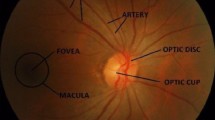Abstract
Glaucoma is one of the ocular diseases which is progressive and irreversible disease. Early detection of glaucoma helps in saving the vision loss permanently. In India, the ophthalmologists are limited in numbers to check the patient. Owing to this, automated detection of glaucoma from the fundus images of the eye region is the state of the art in medical imaging. In this work, the most common method for detection of glaucoma is a parameter called the cup-to-disc ratio is done with deep learning technology. The optic disc and optic cup segmentation are employed with the proposed MultiResUNet architecture which is a fusion of Res and MultiRes paths to U-Net architecture. The areas of the optic disc and optic cup are computed using the segmented images, and the cup-to-disc ratio (CDR) value is further calculated using the areas. The segmentation result from the MultiResUNet segmentation is compared to the standard U-Net segmentation with the Jaccard Index performance metric. The empirical results indicate that MultiResUNet obtained a mean classification accuracy of 97.2% an increase of 7.4% compared to U-Net segmentation.
Access this chapter
Tax calculation will be finalised at checkout
Purchases are for personal use only
Similar content being viewed by others
References
Kuroda A, Enomoto N, Ishida K, Shimazawa M, Noguchi T, Horai N, Onoe H, Hara H, Tomita G (2017) Movement of retinal vessels toward the optic nerve head after increasing intraocular pressure in monkey eyes with experimental glaucoma. Exp Eye Res 162:110–115
Abbas Q (2017) Glaucoma-deep: detection of glaucoma eye disease on retinal fundus images using deep learning. Int J Adv Comput Sci Appl (IJACSA) 8(6)
Damms T, Dannheim F (1993) Sensitivity and specificity of optic disc parameters in chronic glaucoma. Invest Ophth Vis Sci 34:2246–2250
Michael D, Hancox OD (1999) Optic disc size, an important consideration in the glaucoma evaluation. Clin Eye Vis Care 11:59–62
Harizman N, Oliveira C, Chiang A, Tello C, Marmor M, Ritch R, Liebmann JM (2006) The ISNT rule and differentiation of normal from glaucomatous eyes. Arch Ophthalmol 124:1579–1583
Cheng J*, Liu J, Xu Y, Yin F, Wong DWK, Tan N-M, Tao D, Cheng C-Y, Aung T, Wong TY (2013), Superpixel classification based optic disc and optic cup segmentation for glaucoma screening. IEEE Trans Med Imaging 32(6)
Devarajan D, Ramesh SM, Gomathy B (2020) A metaheuristic segmentation framework for detection of retinal disorders from fundus images using a hybrid ant colony optimization. Springer
Aziz L, MD. Haji Salam SB, Sheikh UU, Ayub S (2020) Exploring deep learning-based architecture, strategies, applications and current trends in generic object detection: a comprehensive review. IEEE Access
Van Grinsven MJJP, Venhuizen FG, van Ginneken B, Hoyng CCB, Theelen T, Sanchez CI (2015) Automatic detection of eye diseases using automated color fundus image analysis. Invest Ophthalmol Visual Sci 56:1401
Abràmoff MD, Garvin MK, Sonka M (2010) Retinal imaging and image analysis. IEEE Rev Biomed Eng 1(3):169–208. https://doi.org/10.1109/RBME.2010.2084567
Ronneberger O, Fischer P, Brox T. U-Net: convolutional networks for biomedical image segmentation. https://arxiv.org/pdf/1505.04597.pdf
Ibtehaz N, Sohel Rahman M. MultiResUNet: Rethinking the U-Net architecture for multimodal biomedical image segmentation. https://arxiv.org/pdf/1902.04049.pdf
Litjens G, Kooi T, Bejnordi BE, Setio AAA, Ciompi F, Ghafoorian M, Van Der Laak JA, Van Ginneken B, Śanchez CI. A survey on deep learning in medical image analysis. Med Image Anal 42:60–88
Long J, Shelhamer E, Darrell T (2015) Fully convolutional networks for semantic segmentation. In: Proceedings of the IEEE conference on computer vision and pattern recognition, pp 3431–3440
Badrinarayanan V, Kendall A, Cipolla R (2015) Segnet: a deep convolutional encoder-decoder architecture for image segmentation. arXiv:1511.00561
Author information
Authors and Affiliations
Corresponding author
Editor information
Editors and Affiliations
Rights and permissions
Copyright information
© 2022 The Author(s), under exclusive license to Springer Nature Singapore Pte Ltd.
About this chapter
Cite this chapter
Roshini, R., Alex, J.S.R. (2022). Automatic Segmentation of Optic Cup and Optic Disc Using MultiResUNet for Glaucoma Classification from Fundus Image. In: Saraswat, M., Sharma, H., Arya, K.V. (eds) Intelligent Vision in Healthcare. Studies in Autonomic, Data-driven and Industrial Computing. Springer, Singapore. https://doi.org/10.1007/978-981-16-7771-7_4
Download citation
DOI: https://doi.org/10.1007/978-981-16-7771-7_4
Published:
Publisher Name: Springer, Singapore
Print ISBN: 978-981-16-7770-0
Online ISBN: 978-981-16-7771-7
eBook Packages: Intelligent Technologies and RoboticsIntelligent Technologies and Robotics (R0)




